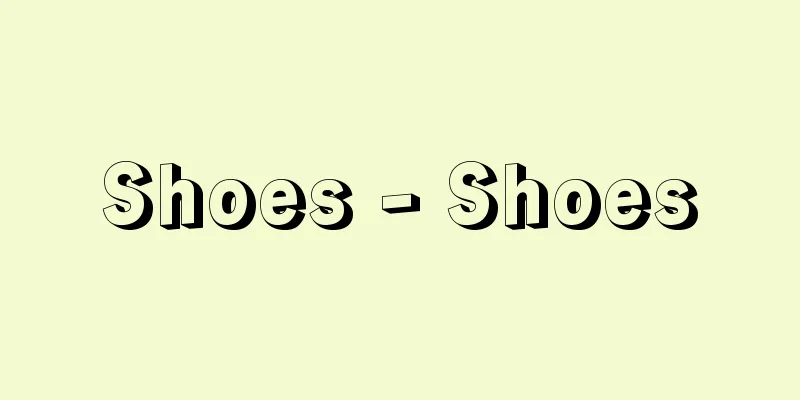Shoes - Shoes

|
A general term for footwear worn on the feet. Kutsu is pronounced "kanokutsu" and originally meant leather footwear that covered the feet, but today it has a narrower meaning and is a general term for mainly Western-style footwear, excluding traditional Japanese footwear for the common people such as geta (wooden clogs), zori (Japanese sandals), and waraji (Japanese straw sandals). Western-style footwear can be divided into closed footwear that covers the feet and open footwear such as sandals and slippers. Kutsu generally refers to closed footwear. Since ancient times in Japan, different characters have been used to refer to "kutsu" (shoes) depending on their use and material. "Kutsu" refers to shoes made of leather, and later the character "kutsu" was also used. It mainly refers to deep shoes worn by military officers, and includes kurikawa no kutsu (crowskin shoes) and hoka (half shoes). Shoe shoes worn by civil servants are written with the character "kutsu" (wear), and include kurikawa sashes. In later times, they came to be made of paulownia wood with a black lacquer coating, but in the Nara period they were made of leather. "Seki" is called "seki no kutsu" and is a type of leather shoe with a decorated curved toe for wearing with formal wear. Sandals are also called "kai" or "ito no kutsu" and include sokai, makai, kinkai, sokai, etc. These were made from fibrous materials and, although there were differences in the manufacturing methods, were used as everyday footwear by everyone from the Emperor to the common people. [Tanaka Toshiko] historyShoes are thought to have been invented for the purpose of protecting the feet from the cold and heat, protecting them from dirt, infiltration and poisonous plants and animals, as decoration, and as a sign of one's status. One of the prototypes of shoes was a closed-type footwear made of a single piece of leather that covered the sole of the foot from the instep, with leather strings tying the edges together and fixing them to the foot; a good example is the moccasin of North American Indians. Over time, this was sewn on one side and gradually shaped. Closed shoes were used by the northern peoples from early times. They were also used by the peoples of Western Asia such as ancient Assyria and Persia, and can also be seen in Japanese clay figurines from the Stone Age and haniwa clay figurines from the Kofun period. Horse-riding peoples had boots. Another prototype is the sandal, which was thought to have been invented primarily for the purpose of protecting the soles of the feet. It is an open-type of footwear consisting of a base on which the foot rests and a string or belt to keep it in place. This was common in warm regions and was used in countries around the ancient Mediterranean. Relics of ancient Egyptian sandals from around 2000 BC still remain. It is not clear when people began to wear shoes, but from examples such as the relics and clay figurines mentioned above, we can infer that various types of shoes were used in various places from a very ancient time. In ancient Egypt and ancient Greece, sandals, which are open footwear, were worn by the upper classes such as kings, nobles, priests, and warriors. Closed moccasin-type footwear appeared a little later and were used for certain types of work. Therefore, they were for the general public. Greek tragic actors wore thick-soled kothornus shoes that made them appear taller. These were inherited by the ancient Romans and then the Byzantines, and the basic form of shoes that covered the entire foot was almost complete in the early Middle Ages. In the mid-Middle Ages, short shoes with laces on the instep appeared among the upper classes. In the 10th century, shoes with pointed toes appeared, and gradually became longer. In the 14th and 15th centuries, during the Gothic period, shoemaking technology improved, and bold, eccentric shoes with abnormally long and pointed toes were popular. Some shoes were as much as 12 inches (about 30.5 cm) longer than the toes of the feet, and were stuffed with wool or linen to keep their shape. Some were so long that they were tied to the knees with chains to support them. As this became too extreme, legal restrictions were frequently imposed in various places. These were called cracows or poulaines (French). When walking on rainy days or in muddy areas, wooden sandals called clogs were worn over them. In the 16th century, during the Renaissance, shoes began to have a reactionary tendency to become wide and angular at the toes. For women, flip-flops called chopins, which had high wooden platforms on which the feet were placed to make the wearer appear taller, also appeared. Wooden clogs, or sabots, had long been used by peasants for work. It was not until the end of the 16th century that footwear took on a natural shape. In the early 17th century, bucket-shaped boots with unusually large openings became popular for men. After that, short heeled boots appeared for both men and women, with angular or rounded toes, a trend that continued until the end of the 18th century. They were decorated with gorgeous embroidery, ribbons, and buckles. With the fashion for classical and ancient customs, sandals were worn by women for a time, but in the early 19th century, boots and light pumps were worn together. In the mid-19th century, the shoemaking sewing machine was invented in America, and in Japan, shoe factories were established and the production of military boots began in Tokyo. Also, perhaps supported by the hygienic idea of the time that not wrapping the ankle was bad for health, deep shoes such as lace-up shoes became mainstream for both men and women, and in Japan they were worn by women during the Rokumeikan period, and later remained for a time in the fashion of female students. In the second half of the 19th century, low-cut oxfords were also produced, and by the end of the century, when sports became popular, short shoes became mainstream and have remained so to this day. During this time, in the early 20th century, shoemaking using sewing machines came into practical use, and after World War II, shoemaking using adhesives and the use of synthetic resins were developed, leading to mass production of shoes. Also, after the miniskirt became popular in the 1960s, various types of boots became popular among women. [Tanaka Toshiko] kinds(1) There are four types of shoes based on their shape: pumps, short boots, short boots (length covering the ankles), and long boots. Depending on the shape of the opening for putting on and taking off, there are shoes with laces (inner wing type has a V-shaped cut in the front of the instep and laces are passed through it and tied, and outer wing type has a V-shaped cut that opens outward and is tied halfway through), and slip-ons that can be put on and taken off without laces, belts, or clasps. There are also shoes with pointed tops, rounded toes, square toes, and other shapes, and some have open toes and heels. The former are called open toes, and the latter are called backless pumps or backband shoes. Depending on the height of the heel, there are high heels, mid heels, low heels, flat shoes, and so on ( ). (2) There are many types depending on the purpose ( ). (3) Depending on the material, they are called leather shoes, cloth shoes, rubber shoes, chemical shoes, etc. Cowhide is often used for the uppers of shoes. Cowhide is abundant as a by-product of meat production, and has dense fibers, is strong, and has a beautiful surface (grain side), making it suitable for a variety of uses. Calf leather is the leather of young calves up to 6 months old, and is finely textured and suitable for high-quality shoes. Kid and kangaroo are also suitable for high-quality shoes. Other leathers used include pig, ostrich, cordovan, crocodile, and lizard. Depending on the animal, some use the surface (grain side) and some use the back (suede, etc.), and the surface finish can be smooth, finely wrinkled, uneven, or enamel. Materials other than leather include synthetic leather, textiles (silk (satin, brocade), linen, cotton (canvas, denim)), rubber, and vinyl. Sole materials include cowhide, synthetic rubber, rubber, synthetic sponge, wood, and cork. [Tanaka Toshiko] ShoemakingThe structure of modern leather shoes generally consists of an instep that covers the instep of the foot, a midsole that comes into direct contact with the sole of the foot, a sole (outsole) that comes into contact with the ground, and a heel ( ). The process of making shoes is divided into cutting the upper leather and the leather or cloth to be attached to the sole, sewing them together with a sewing machine to form the upper, and processing the sole material and attaching it to the upper. The sole can be attached by hand, by machine, or a combination of both, but currently, mass-produced shoes are overwhelmingly more common. The methods of attaching the sole to the upper include sewing with thread, gluing, vulcanizing and pressing the rubber sole, and injection molding the synthetic resin sole, and each method is performed as follows. (1) Stitching (a) Goodyear welt process This is the oldest mechanical shoemaking method, perfected in 1900 by Charles Goodyear II of the United States. The same method as hand sewing is used by machine. The upper, the rib on the insole, and the welt placed around the upper are sewn together, and the outsole is sewn to the welt, which is also called the double-stitch method. It can produce sturdy, durable, and comfortable shoes like men's shoes, but it is expensive. (b) Silhouwelt process Instead of sewing the outsole to the welt as in (a), this is glued on with pressure. (c) Stitch-down process The periphery of the upper is folded outwards and the upper and sole are sewn together. (d) California process The upper and insole are sewn together with the platform leather wrapper into a bag shape, a shoe mold is inserted and shaped, the platform leather is wrapped around the wrapper, and the outsole is glued on with pressure. This allows the production of light shoes using light materials. (e) McKay process The upper, insole, and outsole are sewn together with an inner stitch. This is also called the inner stitch method. Since there is no welt, the appearance is delicate, and it is used for women's shoes and men's formal shoes. It is light and flexible, but not suitable for use in rainy weather. (2) Gluing together This is called the cemented process, and in this method the upper, insole, and outsole are glued together. This was made possible by the development of strong adhesives. It is inexpensive. It is the most commonly used method today. (3) Vulcanizing process The upper and insole are set into a metal mold, and an unvulcanized rubber sole is placed on top of it. Pressure and heat are applied to vulcanize and bond the material at the same time. The adhesive strength is stronger than that of the cement method. The equipment is expensive, and mass production is required. (4) Injection molding method This is called the injection molded system, and molten synthetic resin is injected into a mold to attach the sole to the upper or to mold the entire shoe. [Tanaka Toshiko] sizeIn Japan, shoe sizes were previously measured in mon (a unit of the diameter of a Kan'ei Tsuho coin), with one mon being 2.42 cm, but in 1962 (Showa 37), the currently used 1983 revised sizes were established as JIS (Japanese Industrial Standards). The length from the toe to the heel is the foot length, measured in centimeters, and the circumference of the foot, measured from the base of the big toe to the base of the little toe, is measured with the letters A through G, and both the foot length and circumference are displayed. [Tanaka Toshiko] ComfortIt is believed that shoes that have adequate room at the toes, fit well around the entire foot, are comfortable at the opening, and support the arch (the hard part that does not touch the ground) and the sole of the foot well. It is said that the number of children today who wear shoes instead of sandals or geta (wooden clogs) with insufficient formation of the sole of the foot (flat feet) is increasing. Also, the deformation of the feet of adults, especially women, is becoming more noticeable. The New York State Podiatric Society reports that 99% of people are born with healthy feet, but by the age of 20, 80% of people have foot problems. This is presumably the result of wearing high heels or inappropriate shoes, and it is thought that shoe shapes need to be improved to fit the natural shape of the foot. However, there is also a view that the very act of squeezing the toes together and immobilizing them into socks or shoes is the cause of the deformation of the foot. This problem has a long history, and in modern times, wearing Western-style shoes has served as a sort of pass to enter Western civilization around the world, so it will be quite difficult to solve. [Tanaka Toshiko] Care InstructionsShoe care varies depending on the material of the upper. In the case of the most common shiny leather on the outside, brush off the dust, apply shoe polish and stretch the shoes well, then polish with a woolen cloth to bring out the shine. Use shoe polish and shoe cream to protect the leather and shine it. Oil is needed to protect the leather and stitching, and wax is needed to shine it. For suede, the leather on the inside, brush off the dust with a nylon or wire brush and make it fluffy. If the color has faded, dye it with special ink. For patent leather, remove dirt with a soft cloth and polish with special cream. In general, leather shoes are vulnerable to water, heat, and fire. If they get wet in the rain, dry them in a well-ventilated place and apply shoe polish and maintain them. When storing your shoes, keep a shoe last and shoe keeper inside to prevent them from losing their shape. [Tanaka Toshiko] Customs, stories, proverbsPerhaps because shoes were so familiar to people, ethnic groups that wore shoes have many stories and proverbs about shoes. For example, there are the following: "When shoes are worn, they scratch an itch." "Even new shoes don't hurt your neck." "No man knows where the shoe pinches, but he who wears it." (Only the person who wears the shoes knows where the pinches are. You know yourself best.) In Japan, shoes are removed indoors, but this was also the case in ancient China, and there was a custom in other places of removing shoes in sacred places or in front of people in authority. On the other hand, since the Middle Ages, people in the West have not taken off their shoes in public. Also, until recent years, in rural areas throughout Western Europe, it was customary for the groom to give the bride a pair of shoes. When the bride accepted the shoes and put them on, it became a symbolic act of union. Conversely, removing the bride's shoes was a ritual gesture equivalent to plucking the flower of virginity. [Tanaka Toshiko] Shoe IndustryIn medieval Western society, shoes were important clothing accessories and required high skills to manufacture, so they were a representative branch of the handicraft guild. However, with the development of machine processing technology, mass production by machines progressed, and today, handicrafts are limited to special luxury items. In Japan, the manufacture of Western shoes began in 1870 (Meiji 3) at the request of the Ministry of War, when Nishimura Katsuzo started factory production in Irifune-cho, Tsukiji, Tokyo. Around 1890, it became possible to sew the entire shoe by machine, and shoes suited to the body type, habits, and climate of the Japanese began to be made. It was after World War II that shoes developed into a full-scale industry to meet civilian demand, and saw rapid growth. Production areas are concentrated in Tokyo, Osaka, Nagoya, Yamatokoriyama (Nara Prefecture), Kobe, etc., and the majority of them are small and medium-sized enterprises. The development of mass production by machines is changing the structure of this industry. [Tanaka Toshiko] “RT WilcoxThe Mode in Foot Wear (1945, Charles Scribner's Sons, NY)” ▽ “Shoes” by Eijiro Kanno (1981, Hokuryukan)” [Reference items] | | |footwear| | | | |©Shogakukan "> Shoe types and toe shapes (Figure A) ©Shogakukan "> Names and structure of shoe parts (by shoemaking method) [Figure B] ©Shogakukan "> Classification of shoes by use [Table] ©Shogakukan "> How shoe sizes are displayed ©Shogakukan "> Shoe Size Chart (Men's) ©Shogakukan "> Shoe Size Chart (Women's) ©Shogakukan "> Shoe size chart (for children) Source: Shogakukan Encyclopedia Nipponica About Encyclopedia Nipponica Information | Legend |
|
足に履いて歩く履き物の総称。靴は「かのくつ」と読み、本来は革製の足を覆う履き物を意味したが、今日では、もっと狭義に、日本在来の庶民的履き物である下駄(げた)、草履(ぞうり)、草鞋(わらじ)などを除く、主として西洋風履き物の総称となっている。西洋風履き物には、足を覆い包む閉鎖的履き物と、サンダルやスリッパのような開放的履き物とがある。靴は一般に閉鎖的履き物をさす。 わが国では古くから「くつ」に、用途や素材によって異なる文字をあてていた。靴は革製のくつをいい、のちには沓の字もあてた。主として装束の武官用の深ぐつをさし、烏皮靴(くりかわのくつ)、半靴(ほうか)などがある。文官用の浅ぐつは履(くつ)の字をあて、烏皮履がある。後世には黒漆塗り桐製になるが、奈良時代には革製である。舃は「せきのくつ」とよび、つまさきが反り上がって飾られている革製礼服(らいふく)用のくつである。 鞋は「かい」「いとのくつ」ともよび、挿鞋(そうかい)、麻鞋(まかい)、錦鞋(きんかい)、草鞋(そうかい)などがある。これらは繊維性の素材でつくられ、製法の違いはあったが、天皇から一般庶民までの普段ばきとして用いられた。 [田中俊子] 歴史靴は、足部の防寒・防暑や、汚れ、浸潤、害毒のある動植物からの保護や、装飾、身分表示などの目的で案出されたと考えられる。靴の原型の一つは、一枚革で足の底部から甲までを覆い包み、その周縁を革紐(かわひも)で縛りまとめて足に固定させる閉鎖的履き物であり、北米インディアンのモカシンmoccasinがその好例である。これはやがて、いずれかの面で縫合されるなどして、しだいに形を整えていった。 閉鎖的な靴は、北方諸民族間に早くから用いられた。古代アッシリアやペルシアなど西アジアの民族にも同様にあり、日本の石器時代の土偶、古墳時代の埴輪(はにわ)にもみられる。騎馬民族にはブーツがあった。 他の原型の一つは、足の裏の保護が主目的で案出されたと思われるサンダルで、足をのせる底の台と、それが足から離れないようにする紐や、ベルトから構成されている、開放的な履き物である。これは暖かい地方に多く、古代地中海周辺諸国に用いられた。紀元前2000年ごろの古代エジプトのサンダルの遺品が現存している。 靴がいつごろから用いられるようになったかは明らかでないが、前述の遺品や土偶などの例からも、かなり古い時代から各地で各種の靴が用いられたと推察できる。古代エジプトや古代ギリシアでは、開放的な履き物であるサンダルが王、貴族、僧、戦士などの上流階級に用いられた。閉鎖的なモカシン型の履き物は少し遅れて現れ、ある種の労働に用いられた。したがって民衆用であった。 ギリシア悲劇の俳優には、背を高くみせる厚底のコトルヌスkothornusがあった。これらは古代ローマに引き継がれ、さらにビザンティンに継承されて、足部全体を包む靴の基本形が中世初期にほぼできあがる。 中世中期には、甲を紐締めにした短靴形式が上級階級に登場する。10世紀につまさきのとがった靴が現れ、その後徐々に長さを増し、14、15世紀、ゴシックの時代には製靴技術も進んで、つまさきが異様なまでに長くとがった大胆奇抜な靴が好まれた。足のつまさきより12インチ(約30.5センチメートル)も長いものも出現し、中にウールや麻くずを詰めて形を保った。なかには長すぎたため、鎖で膝(ひざ)に結わえて支えたものもあった。極端になったために、法による規制も各地でたびたび行われた。これらはクラコーcracowとかプーレーヌpoulaine(フランス語)とよばれた。雨の日やぬかるみを歩くときには、この上にクロッグclogという木製のサンダルを重ねた。 16世紀、ルネサンスの時代になると、反動的に幅広で角張ったつまさきの短靴になる。女子には、背を高くみせる木の高い台に足をのせる、つっかけ式のチョピンchopinも登場した。農民の労働用には古くから木靴サボsabotがあった。履き物が自然な形になるのは16世紀末になってからである。17世紀初期の男子には、履き口の異様に大きいバケツ型ブーツが流行する。その後、男女ともにヒールのある短靴が登場し、つまさきが角張ったり丸みを帯びたりして18世紀末まで続く。刺しゅうやリボンやバックルの装飾が華やかであった。 古典古代風俗の流行とともに一時サンダルが女性に履かれるが、19世紀初期にはブーツと軽やかなパンプスが併用される。中期にはアメリカで、製靴用ミシンの発明をみ、日本でも製靴工場が設立されて軍靴の製造が東京で始まっている。また、足首をくるまないことは健康に悪いという当時の衛生思想に支えられてか、編上げ靴などの深靴が男女ともに中心になり、わが国でも鹿鳴館(ろくめいかん)時代に婦人に履かれ、のち女学生の風俗にしばらく残ることとなる。19世紀後半にはローカットのオックスフォードもつくられ、スポーツが普及した19世紀末には短靴が中心となり、今日に至っている。 その間、20世紀初頭にはミシンによる製靴法が実用化、さらに第二次世界大戦後は接着剤による製靴法や合成樹脂材の使用などが開発され、靴は量産化した。また、1960年代のミニ・スカートの流行以降、婦人に各種ブーツが普及した。 [田中俊子] 種類(1)形から次の4種がある。浅靴(パンプスpumps)、短靴(シューズshoes)、深靴(ショート・ブーツshort boots、くるぶしを覆う長さ)、長靴(ロング・ブーツlong boots)。以上のものはそれぞれ、着脱用あきの形によって、紐付き(甲の前がV型に切り込まれ紐を通して結ぶのが内羽根式、V型切り込みが外へあいて、その途中を結ぶのが外羽根式という)、紐やベルト、留め金なしで着脱できるスリップ・オンなどがある。また、つまさきの形もそれぞれ、とがったもの(ポインティッド・トップ)、丸みを帯びたもの(ラウンディッド・トウ)、角張ったもの(スクエア・トウ)などがあり、つまさきやかかと部分の開放されたものもある。前者をオープン・トウ、後者をバックレス・パンプスとかバックバンド・シューズとかいう。ヒールの高さによってハイヒール、中ヒール、ロウヒール、フラット・シューズflat shoesなどがある()。(2)用途によって多種ある()。(3)材料によって、革靴、布靴、ゴム靴、ケミカル・シューズなどとよばれる。靴の甲に用いられる革は牛革が多い。牛革は食肉の副産物として豊富であり、繊維質も緻密(ちみつ)で強く、表面(銀面)が美しいので、あらゆる用途に向く。カーフcalfは生後6か月までの子牛の革で、きめ細かく高級靴向き。キッド、カンガルーも高級靴向き。ほかに豚、オーストリッチ、コードバン、ワニ、トカゲなどが使われる。動物によって、表面(銀面)を使うものと裏面(スエードなど)を使うものとがあり、表面の仕上げも、滑らかに仕上げたもの、細かいしわづけをしたもの、凹凸をつけたもの、エナメル仕上げしたものなどがある。皮革以外の材料として合成皮革、織物類〔絹(サテン、ブロケード)、麻、木綿(キャンバス、デニム)〕、ゴム、ビニルなどが用いられる。底の材料には牛革、合成ゴム、ゴム、合成スポンジ、木、コルクなどが用いられる。 [田中俊子] 製靴法現代の一般的革靴の構造は、足の甲部分を覆っている甲と、足の裏が直接触れている中底、地面に接する底(表底)、かかと(ヒール)部からなる()。 靴をつくる工程は、甲革とその裏につける革や布を裁断し、ミシンで縫い合わせて甲部を成型する作業と、底材を加工して甲に取り付ける作業とに分かれている。底を取り付けるには、手作業によるもの、機械によるもの、両者併用するものがあるが、現在では機械による量産品が圧倒的に多い。甲に底を取り付ける方法には、糸で縫い合わせる、接着剤で張り付ける、ゴム底の加硫圧着、合成樹脂底の射出成型などがあり、それぞれ以下のようにして行われる。(1)縫い合わせ (a)グッドイヤー・ウェルト式Goodyear welt process もっとも古い機械による製靴法で、1900年アメリカのチャールス・グッドイヤー2世によって完成された。手縫いと同じ方法を機械で行う。甲と中底につくったリブと甲の周りにあてがったウェルトの三者を縫い合わせたのち、ウェルトに表底を縫い付けるもので複縫式ともいう。紳士靴のようながっちりした、じょうぶで、履き心地のよい靴をつくりうるが、コスト高になる。(b)シルウェルト式silhouwelt process (a)式でウェルトに表底を縫い付ける工程にかえて接着剤で圧着する。(c)ステッチダウン式stitch-down process 甲部周辺を外側に折り出し、甲と底革を縫い合わせる。(d)カリフォルニア式California process 甲と中底をプラットフォーム巻革とともに袋状に縫い合わせ、靴型を挿入して成型し、プラットフォームに巻皮を巻き付けたのち、接着剤で表底を圧着する。軽い素材を使用した、軽い靴の製作が可能である。(e)マッケイ式Mckay process 甲、中底、表底の三者を、いっしょに内縫い式によって通し縫いする方法。内縫い式ともいう。ウェルトがないため外観がきゃしゃな感じで、婦人靴や男子のフォーマル靴に用いられる。軽く柔軟であるが、雨降りには向かない。(2)接着剤による張り合わせ セメント式cemented processといい、甲、中底、表底を接着剤によって張り合わせるもの。強力な接着剤の開発によって可能となった。コストが安い。現在もっとも多く行われている方法。(3)バルカナイズ式Vulcanizing process 甲と中底を金足型にセットし、これに未加硫ゴム製の底を置き、圧力と温度をかけながら加硫と接着を同時に行う。接着強度がセメント式より強い。設備に費用がかかり、量産を要する。(4)射出成型法 インジェクション・モールデッド法injection moulded systemといわれ、溶かした合成樹脂を金型に注入して、甲に底をつけたり、靴全体を成型したりする。 [田中俊子] サイズ日本では以前、靴のサイズを寛永通宝(かんえいつうほう)一文(いちもん)銭の直径、2.42センチを一文とする文数で表していたが、1962年(昭和37)に、現在用いられている1983年改定サイズがJIS(ジス)(日本工業規格)で制定された。これは、つまさきからかかとまでの長さを足長とし、センチメートルで表し、親指の付け根と小指の付け根を通る足囲をA~Gの文字で表し、足長と足囲をあわせて表示する。 [田中俊子] 履き心地つまさきに適当なゆとりがあり、足全体によく適合し、履き口に無理がなく、靴のアーチ部分(地面につかない固い部分)と足の土ふまずとがよくあって支えている靴が履き心地がよい、と考えられている。草履(ぞうり)や下駄(げた)ではなく、靴を履くようになった現代の子供には、土ふまずの形成不十分な扁平足(へんぺいそく)が増加しているといわれている。また大人、とくに婦人の足のゆがみも目だってきている。誕生時には99%の人が健全な足だが、20歳になると80%の人が足を痛めているというニューヨーク州足病学会の報告もある。これは、ハイヒールや、適切でない靴を履いた結果と推察され、靴形を自然な足にあうよう改良する必要があると考えられる。しかし、足指をくっつけて動かなくして靴下や靴に押し込めること自体が足をゆがめる原因であるとの見方もある。長い歴史があり、近代に入ってからは、世界的に西洋風の靴を履くことが西洋文明への入場許可証のような役割を担ってきた経緯もあり、この問題の解決はかなり困難であろう。 [田中俊子] 手入れ法靴の手入れは、甲の素材によって異なる。もっとも一般的な表出しの光沢のある革の場合は、ブラシでほこりを払ったのち、靴ずみをつけてよく延ばし、毛織布で磨いて光沢を出す。保革やつや出しのために靴ずみや靴クリームを用いる。保革、縫い糸の保護のためには油分が、つや出しのためには蝋(ろう)分が必要である。裏出しの皮であるスエードは、ナイロンかワイヤーのブラシでほこりを払いながら毛羽立てる。色が落ちた場合は専用インクで染める。エナメル革は柔らかい布で汚れを落とし、専用クリームで磨く。一般に革靴は水、熱、火に弱い。雨にぬれたら風通しのよい所で乾かし、靴クリームをつけて手入れをするとよい。しまっておくときには、靴型、シュー・キーパーを入れておくと型くずれしない。 [田中俊子] 習慣、故事、ことわざ人々に身近だったせいか、靴を用いる民族には靴に関する故事、ことわざは多い。たとえば次のようなものがある。隔靴掻痒(かっかそうよう)。履(くつ)新(あたらし)と雖(いえど)も首に加えず。No man knows where the shoe pinches, but he who wears it.(靴を履いている者だけが締め付ける箇所を知っている。自分のことは自分がいちばんよく知っている)など。 また、日本では室内で靴を脱ぐが、中国古代でも同様であったし、神聖な場所や権力者の前では脱ぐ習慣が各地にあった。一方、中世以降、西洋の人々は人前では靴を脱がない。また西欧各地の農村では花婿は花嫁に1足の靴を贈る習慣が近年まであった。花嫁がそれを受け取り、履くと結合の象徴的行為となった。逆に花嫁の靴を脱がせることは、処女の花を摘み取るという儀式的ジェスチャーであった。 [田中俊子] 靴産業西洋中世社会で、靴はたいせつな服飾品であり、製造には高い技術を要したことから、手工業ギルドの代表的な部門であった。しかし、機械加工技術の発展とともに機械による量産化が進み、今日では手工業によるものは特別な高級品に限定されるようになった。日本の西洋靴の製造は、兵部(ひょうぶ)省の要請によって1870年(明治3)に工場生産が東京・築地(つきじ)入舟町で西村勝三により始められた。1890年ごろには全体をミシンで縫えるようになり、その後、日本人の体型、習慣、風土に適したものがつくられるようになる。民需による本格的な産業として発展したのは第二次世界大戦後であり、急速な発展をみた。産地は東京、大阪、名古屋、大和郡山(やまとこおりやま)(奈良県)、神戸などに偏在し、中小企業が圧倒的に多い。機械による大量生産方式の発達は、この業界の構造を変えつつある。 [田中俊子] 『R. T. WilcoxThe Mode in Foot Wear (1945, Charles Scribner's Sons, N.Y.)』▽『菅野英二郎著『靴』(1981・北隆館)』 [参照項目] | | | | | | | | | |©Shogakukan"> 靴の種類とつまさきの形〔図A〕 ©Shogakukan"> 靴の各部名称と構造(製靴法別)〔図B〕 ©Shogakukan"> 靴の用途別分類〔表〕 ©Shogakukan"> 靴のサイズの表示方法 ©Shogakukan"> 靴のサイズ表(男子用) ©Shogakukan"> 靴のサイズ表(女子用) ©Shogakukan"> 靴のサイズ表(子供用) 出典 小学館 日本大百科全書(ニッポニカ)日本大百科全書(ニッポニカ)について 情報 | 凡例 |
<<: Kutsukake [Hot Spring] - Kutsukake
>>: Shoes (kutsu/shoes) - shoes
Recommend
Horse chestnut (Aesculus turbinata Bl.)
A deciduous tall tree of the Aesculaceae family wi...
Baia
...This fact indicates that there was already a l...
Karma
Jainism was the first school in India to preach a...
Yoshiroku - Kichiroku
⇒ Ida Kichiroku Source: Kodansha Digital Japanese ...
"Record of the Kitano Tea Ceremony"
...It is said that 1,500 tea houses were built on...
Pre-indictment settlement - Kisozen no wakai
... Mediation of labor disputes by the Labor Rela...
Wei Heng - Eiko
… [Mikuni to Nanbokucho period] From the Three Ki...
Heiro Kitagawa
Dyeing and weaving artist. His real name was Heir...
Absorption spectroscopy
...This trend has been further accelerated by tec...
Chara zeylanica (English spelling)
…[Mitsuo Chihara]. . . *Some of the terminology e...
Power - Kenryoku
When a person (group) makes another person (group)...
Keene, C.
…He grew up as an orphan, joined a troupe of trav...
Longitudinal wave
...In an elastic body, volume elasticity causes w...
Ippongata Nadohyoiri - One-sword entry into the ring
A play by Hasegawa Shin. Two acts. Published in t...
Shah (English spelling) shāh
In Early Modern Persian, it means "emperor&qu...









